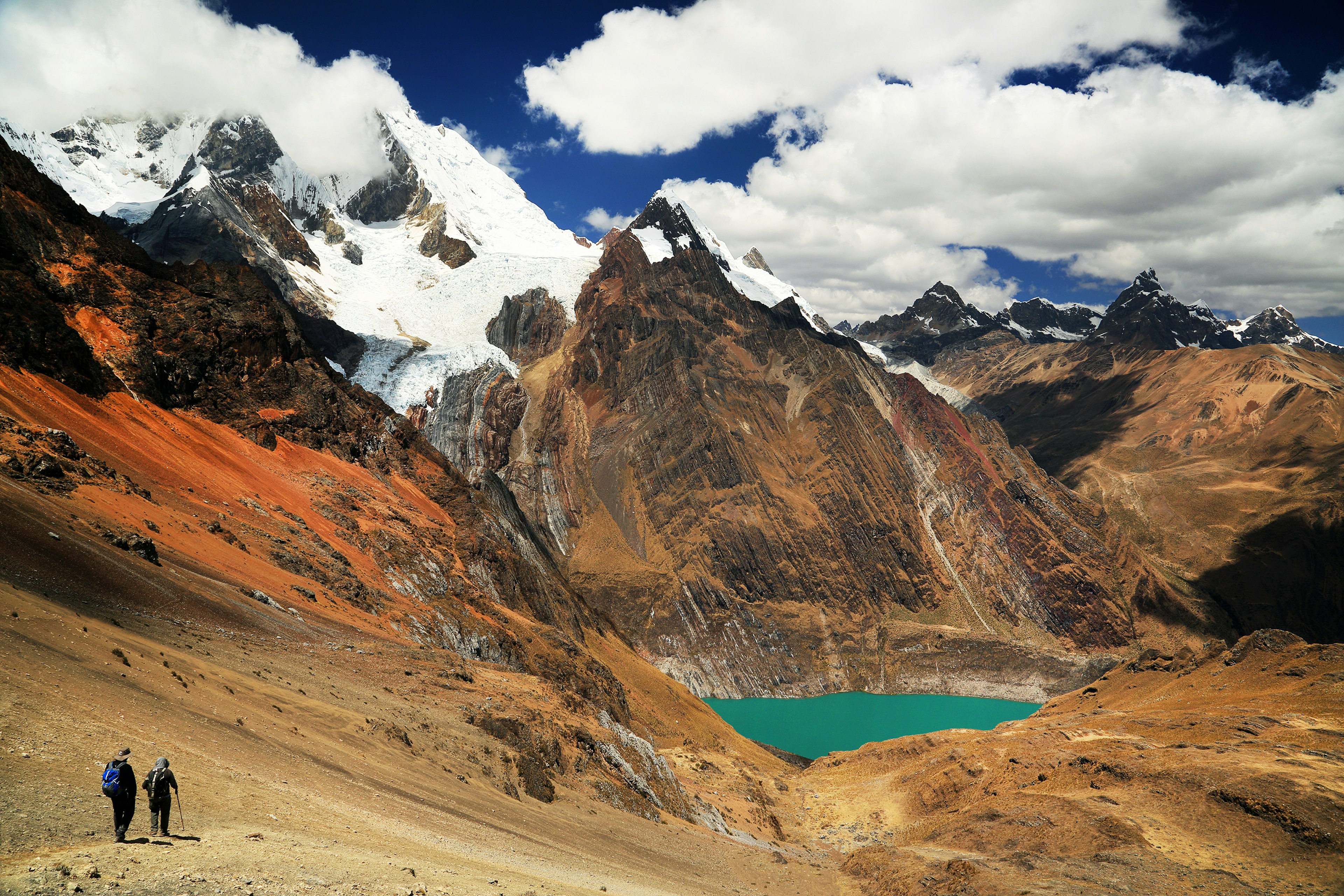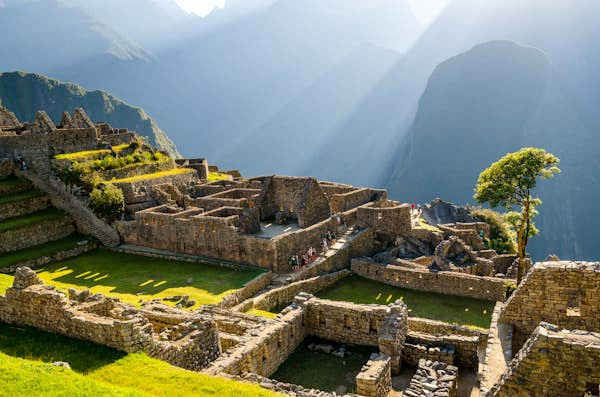Renowned for its gastronomy, revered for its cultural legacies and marveled for its biodiversity, Peru has an endless list of reasons to keep visitors coming back for more – how else would you be able to see, taste and do it all?
With landscapes ranging from sky-scraping mountain peaks and wild, untamed jungle to the glittering shores of the Pacific Ocean, this South American powerhouse has activities and experiences that are as varied as its terrain.
All this and the chance to wander amidst sky-high Inca ruins and remnants of pre-Hispanic civilizations once buried beneath desert sands – it can be difficult to know where to begin. Start your must-visit list now with these 13 amazing places to visit in Peru.
1. Machu Picchu
Best for trekking
One of the New Seven Wonders of the World and Peru’s greatest claim to tourism fame, Machu Picchu lives up to its hype as a mystical and awe-inspiring 15th-century archaeological site. Built with incredible precision, attention to detail and at the great height of 2430m (7972ft) above sea level, Machu Picchu includes temples, private quarters and ceremonial platforms that continue to radiate sacred energy.
Machu Picchu, meaning “old peak” in the Indigenous Quechua language of the Andes, can be reached by a two-hour train ride from the Sacred Valley town of Ollantaytambo, or the truly intrepid can walk in the footsteps of the Incas along the classic Inca Trail, a four- to five-day trek that traverses 42km (26 miles).
Local tip: The weather at Machu Picchu seems to have only two settings: heavy rain or bright, burning sunlight. Don’t forget rain gear and sunblock.

2. Caral
Best for desert explorers
It is mind-boggling how few tourists make it to the ancient city of Caral, built around 5000 years ago and still impressively conserved. Located in the high desert of the Supe Valley, a 3.5-hour car ride from the capital city of Lima, the UNESCO World Heritage Site predates ceramic pottery and the Incas.
It is the key to understanding the beginning of Andean culture, a visible shift from separate tribes to a shared urban community. With a guide, visitors can stroll through what was once a complex city of the Norte Chico culture, consisting of mud-brick amphitheaters, ceremonial rooms, circular plazas and the remains of six pyramids: remnants of urban planning and agricultural practices that would greatly influence subsequent cultures in Peru.
3. Kuelap
Best for archaeology enthusiasts
In the Amazonas region of northern Peru, a walled settlement known as Kuélap has stood among the clouds since the 7th century. Built by the Chachapoyas culture (referred to as “Cloud Warriors”), the fortress is often called the Machu Picchu of the North, despite its higher elevation of 3000m (9842ft) above sea level and the fact that it predates the Inca citadel by at least 500 years. Hundreds of circular structures are spread across the site, making it one of the largest sites of stone ruins in the Americas.
Planning tip: Getting to Kuélap is now easy in a day trip from Chachapoyas. Cable cars drop off visitors at the top.

4. The Sacred Valley
Best for handicrafts
The heart of the Inca Empire, the Sacred Valley (Valle Sagrado) is indeed the gateway to Machu Picchu, but what rushed travelers often overlook are the villages cradled within the valley that are home to lesser-known archaeological sites, first-rate artisan workshops and living cultures of the Peruvian highlands.
An hour’s drive from Cuzco, the bohemian town of Pisac boasts its own hilltop Inca citadel and one of the best handicraft markets in the region. To the northwest is Urubamba, a hub for adventure tourism, including rock climbing, trekking and downhill biking. The neighboring village of Ollantaytambo is home to the eponymous Inca fortress.
Local tip: Recent years have seen an influx of expats and New Agers to Pisac in search of an Andean Shangri-la. The local tourism industry has responded with everything from yoga retreats and cleanses to guided hallucinogenic trips.

5. Huaraz
Best for mountaineering
Defined by Cordillera Blanca, one of the most impressive mountain ranges in the world, Huaraz is Peru’s capital of mountaineering. The town itself is rather low-key, but it is home base for a number of outdoor excursions, which makes Huaraz a must-visit destination.
Verdant valleys give way to the snowy summits of the Cordillera, accessorized with jade lakes and pristine springs. Experienced trekkers set their sights high to reach the 6768m (22,205ft) summit of Huascarán, a three-week journey. Meanwhile, day trips to sites like Laguna Churup are satiating for beginners or time-constrained adventurers.

6. Arequipa
Best for colonial-era architecture
Known as Peru’s White City for its unique colonial-era architecture crafted from volcanic rock (sillar), Arequipa is one of the most visually stunning cities in the country. Just beyond the chalky structures of the main plaza are deep-hued testaments to the city’s past, such as the blue and red Monasterio de Santa Catalina, built in 1579 and vibrant picanterías (traditional lunchtime restaurants).
On the outskirts of the volcano-framed city is the Ruta del Sillar (Volcanic Rock Route), showcasing the material’s extraction, production and the lives of the workers. Witness the breathtaking flight of the giant Andean condor from the brink of Cañón Del Colca (Colca Canyon), one of the world’s deepest canyons and a top trekking destination in Peru.

7. Lake Titicaca
Best for getting out on the water
Separating Bolivia and Peru, Lake Titicaca was a sacred body of water to the Incas. In fact, Andean mythology often points to the high-altitude lake as the place of origin of the first Inca, Manco Capac, and his wife, Mama Ocllo.
A geological wonder, Lake Titicaca lies at 3812m (12,506ft) above sea level, making it the highest navigable body of water in the world. Glide out to the floating reed islands that dot the lake to meet the Uros people, who live a fascinating life committed to the preservation of Indigenous handicrafts and fishing. Tourism is incredibly important for this community and some families offer homestays.
Local tip: Bring warm layers if you plan to stay out on deck. Three types of boats ply these waters. Veloz (high-speed speedboats), lancha rápida (speedboats) and embarcaciones artesanales (traditional boats), which take twice as long as the speedboats.

8. Choquequirao
Best for intrepid hikers
Can you imagine having Machu Picchu to yourself? Full of history, challenging hikes and privileged views, Choquequirao is often described as a mini Machu Picchu, but not for its size. At least twice as large as the famed Inca citadel and similar in structure, Choquequirao can only be considered diminutive in terms of visitor numbers.
A minimum four-day round-trip of steep climbs filters out many potential visitors, leaving only the most intrepid of hikers. At an elevation of 3050m (10,006ft), much of Choquequirao remains buried by thick jungle foliage. To reach this high-elevation gem with few other visitors is like stumbling upon hidden treasure, or as its name means in Quechua, a “cradle of gold.”
Planning tip: Bring a water filter – the water found along the way is not potable. Fill up when you can as water sources are infrequent.
9. Oxapampa
Best for the unexpected
A jungle town founded by Austrian and German colonists in the 19th century, Oxapampa is a unique visit with unexpected architecture and local food. Just beyond the main plaza and the Tyrolean architecture are lush mountainsides ideally explored by foot or bike.
A bit farther away is Yanachaga-Chemillén National Park. A new wave of residents, largely from Lima, arrived in the past decade, resulting in new sustainable tourism ventures and greater impulse to continue Selvámonos, an annual music and culture festival.
Planning tip: An 80km (50-mile) bus ride away lies Pozuzo, Oxapampa’s smaller yet older neighboring town, which hosts its own version of Oktoberfest, called Pozuzofest.

10. Puerto Maldonado
Best for wildlife
Capital of the southern Amazon rainforest, Puerto Maldonado offers easy access to prime, wildlife-rich jungles in Peru. From here, visitors can venture into the Tambopata National Reserve, one of the last few pristine areas in the rainforest. Spread over 2745 sq km (1060 sq miles) and marked by lakes, rivers and forest, the protected area is one of the most biodiverse destinations on the planet, boasting thousands of butterfly species as well as hundreds of varieties of birds, mammals and plants.
Located in the Madre de Dios region, Puerto Maldonado is a 1.5-hour flight from Lima. Popular with travelers of all ages, the city is far more laidback than its bustling cousin up north, Iquitos, making it more attractive for families and an extended stay.

11. Ica
Best for sandboarding adventures
In the vast Ica desert lies the surreal desert oasis, Huacachina. Rest your eyes upon the sparkling body of water (inhabited by mermaids, according to local legends) before plunging down the dunes upon a sandboard or in a dune buggy for an absolute adrenaline rush.
Escape from the harsh desert sun at midday by looking around the impressive Regional Museum of Ica or on a tasting tour of Peru’s national spirit, pisco. With year-round sunshine and just four hours from Lima by car or bus, Ica can provide entertainment for days. If that’s not enough, the famed Nazca Lines and Islas Ballestas, the so-called “poor man’s Galapagos,” are just 1.5 hours away.
12. Cajamarca
Best for Inca history and local food
The northern Andean town of Cajamarca was the fateful capture site of the last Inca, Atahualpa, by the Spanish conquistadors in the 16th century. Remnants of the area’s Inca history abound, including the Cuarto del Rescate (Ransom Room) that Atahualpa had filled with treasures to plead for his liberation as well as his favored thermal baths, now called Los Baños del Inca. Slow down and explore the idyllic countryside nearby: get your hands dirty on an immersive visit to the dairy farm of Granja Porcón, or visit the archaeological complex of Cumbemayo.
Local tip: Cheese is the Cajamarca specialty and is sold in numerous shops in and around the Plaza de Armas.

13. Barranco, Lima
Best for boho vibes
Bohemian, hip and creative Barranco is hands down the coolest district in the capital city of Lima. The coastal neighborhood is walkable and numerous boutique shops, bars and cafes decorate nearly every block. World-renowned restaurants such as Central, Kjolle, Isolina and Merito all call this district home.
Many local artists reside in or have studios in Barranco, which means a gallery or exhibit is never far away. Duck into Jade Rivera World for street-art-inspired pieces or the sizable Museo de Arte Contemporaneo, as well as artisan shops such as Puna, Dédalo and Las Pallas.
Local tip: Join the locals sipping potent pisco cocktails at vintage bars, refurbished mansions and chic lounges around Parque Municipal, which throngs with revelers on Friday and Saturday nights.
This article was first published Aug 12, 2021 and updated Oct 25, 2024.

